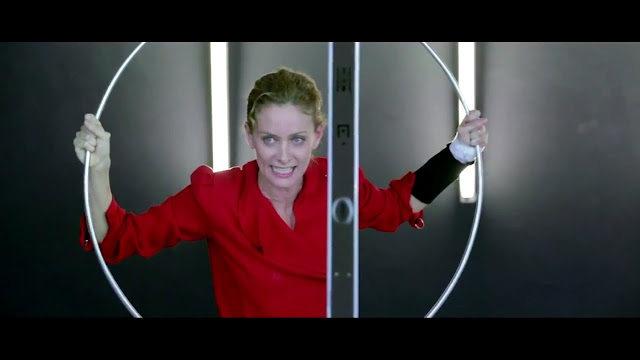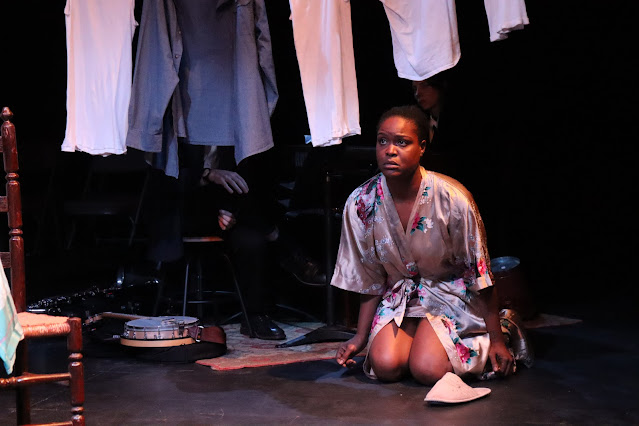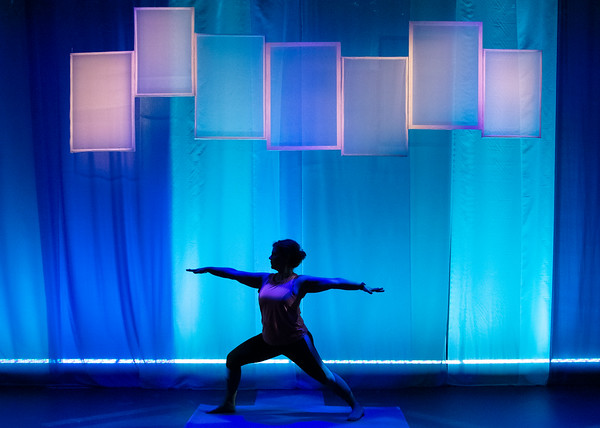Review: "The Second Coming of Joan of Arc" Stages Some Potent Revelations
The Second Coming of Joan of Arc (Giovanna d'Arco – La rivolta)
Written by Carolyn Gage
Translated by Edy Quaggio
Directed by Ester Tatangelo and Luchino Giordana
Presented by Hermit Crab Production at NOoSPHERE Arts on May 11, 2024, at 8:30 pm and Theaterlab on May 12, 2024, at 8 pm
 |
| Valentina Valsania. Photo by Angelo Maggio |
The play takes the form of an extended monologue by Joan (Valentina Valsania, in a blazing performance)–or, Jeanne: she notes that both halves of the name by which she is now known are actually incorrect. Jeanne's story is framed early on by the thesis that she has become a mere insert in the history books, hemmed in and contained by a border, and that her story, both in this and in its defining contours, is all women's stories. She begins her narrative moving to decidedly non-15th-century electro music while she establishes how her fellows abandoned her to capture on the field of battle. Later, her tale glosses quickly over the political and military exploits on which traditional–i.e., patriarchal–histories focus (this is, after all, the tale of Jeanne, not Joan). She lingers instead on subjects such as how Saints Michael, Catherine, and Margaret functioned as her internal voices–and she stresses that they were her voices, part of herself–and, in a way, role models and how the endings of their stories reflect their genders and what that means for women more generally; or such as her imprisonment and trial: she acidly enumerates all the male "experts'' arrayed against a single teenage girl, notes the impact of fragile male egos on the proceedings, and highlights the inquisitors' focus on her voices and clothes. Her crimes, in the end, officially amount to not offering submission to the Church's–and so, by default male–authority. Ultimately, she reaches the moment of her execution as a heretic, when she experiences a complete reframing of her life that is defiant; for both her and the audience, deeply impactful; and for the latter, even cathartic.
The play does not end with this woman's fiery murder, however, but with a coda that elevates women's love for one another above, for example, any martial heroism. Jeanne's comparison of herself to other women–whether her mother, whose voice as a person has almost vanished, or her friend, through whose experiences she comes to puberty as opening a gateway to a foreign invasion of the self, which she resists–helps to steer her onto the path that she takes: away from the choices of marriage, children, or convent and into male attire and one of those inserts in the history books. All of this of course also links her to contemporary women and vice-versa. These parallels include her discussion of how, before she adopted male clothing, her dress spoke for her before she did at her first meeting with a governor (by this point, Valsania has already shed the red dress in which she begins the performance in favor of something quite different and much more black); "women's" clothing comes in for derision more than once as impractical and even unsafe, and Jeanne's self-correction late in the play from "men's" clothes to "human" clothes points to how clothing is used to construct women as a lower class in the heteropatriarchal hierarchy. Relatedly, and providing another parallel with contemporary women, Jeanne describes the many ways of torturing women that don't require physical violence, from shame, gaslighting, and the cultivation of fear to belittling and erasure. And giving in, she concludes, as she did when she confessed and promised to renounce male attire, only brings more abuse. Eventually, however, she also realizes the mistake of looking for what she needed in the world of men, an epiphany that would certainly benefit our culture more widely. Valsania's riveting turn as Jeanne is enhanced with minimal props–a metal hoop, a step-ladder, a finicky spotlight–and some atmospheric use of light and sound, including the lighting of one scene only by flashlight and the intermittent use of a microphone. The upright lighting at the front of the performance area perhaps itself suggests another border for Jeanne, but one that Valsania crosses with her powerful delivery long before she physically steps across it. As the saints served as guiding voices for Jeanne, perhaps Valsania's Jeanne can serve as such a voice for (potential) rule-breaking women, non-(hetero)normative women everywhere.
-John R. Ziegler and Leah Richards
More from the 2024 In Scena! Italian Theater Festival:
News: In Scena! Italian Theater Festival NY 2024 Announces Performance Schedule and Awards
Review: "Help Wanted" Needs No Help Making Feminist Motherhood Funny
Review: "Sciara - Prima c'agghiorna" Poignantly Presents a Little-Known Part of Women's History
Review: "The Great Magic" Casts an Entrancing Spell
Review: "Opera Buffa!" Orchestrates an Extended Aria of Absurdity
Review: The Barbarity of Prison Extends Beyond Its Walls in "The Visit"
Review: "Like a Little Grain of Sand" Explores an Enormous Injustice
Review: "The Genesis of Regeneration" Spins a Hilarious Yarn
Review: "Persona Metropolitana" Sways to the Rhythms of Urban Life



Comments
Post a Comment